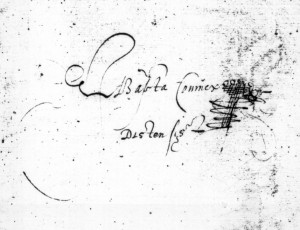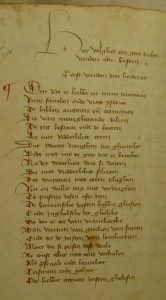The fourth story of the Geraardsbergen Manuscript has been suggested by the Flemish scholar Theo Coun.
According to Coun, the Geraardsbergsen Manuscript was once part of a chained library (?). This type of library was common in the later Middle Ages. The books were chained to the shelves or the lecterns to prevent them from being taken by the readers.
To enable the reader to find a specific book, chained books often had a fenestra on the cover: a little window made of horn and attached with small metal strips and nails along the sides, behind which a piece of paper or parchment with the title of the book was placed.
On the inside of the modern back cover of the Geraardsbergen Manuscript some remains of the old leather cover have been attached to the wood. In this strip of leather a rectangular shape of little holes can be clearly discerned. Coun assumes that these are traces of a fenestra, which used to be on the back of the book!
But there’s more. When we buy a book nowadays and write our name in it to mark it as our property, we usually do so at the beginning of a book. A sixteenth century owner of the Geraardsbergen Manuscript, Sjodocus Croy, however, wrote his name at the end of the first codicological unit (?) of the manuscript, which may imply that the codex was already lying on the front cover before the second unit was attached.
For modern man, a title on the back of a book (or an owner mark at the end) seems a little strange, but in a chained library it all depended on the chain: it could be attached to the front or to the back cover. If it was attached to the back cover, the book would be kept with its back on the lectern, but when it was attached to the front, it was easier to keep the book with its front cover to the lectern, otherwise the chain would have to be moved on opening the codex (which might damage the book).
Chained libraries are usually institutional libraries with a public function (and therefore with a reason to avoid theft). Regional differences in storing the books occur and in the Low Countries they coincide more or less with the boundaries of the dioceses. The diocese of Cambrai for instance has the habit of resting the books on their back. Therefore one would expect that a manuscript from Geraardsbergen, located in this diocese, would have been kept on its back with a fenestra on the front cover, but this is not true for the Geraardsbergen Manuscript…
Coun argues that, since the Geraardsbergen Manuscript is not an institutional manuscript it should not necesarilly follow the habits of the diocese. In his opinion, the later owner of the manuscript, Sjodocus Croy may have been a professional writer who wrote manuscripts under commission. In his shop, there could have been lecterns with manuscripts (on their front cover) containing sample texts, offering the customers a wide varierty of texts to chose from.
For more details, see: further reading
Back to the five stories of the Geraardsbergen Manuscript




